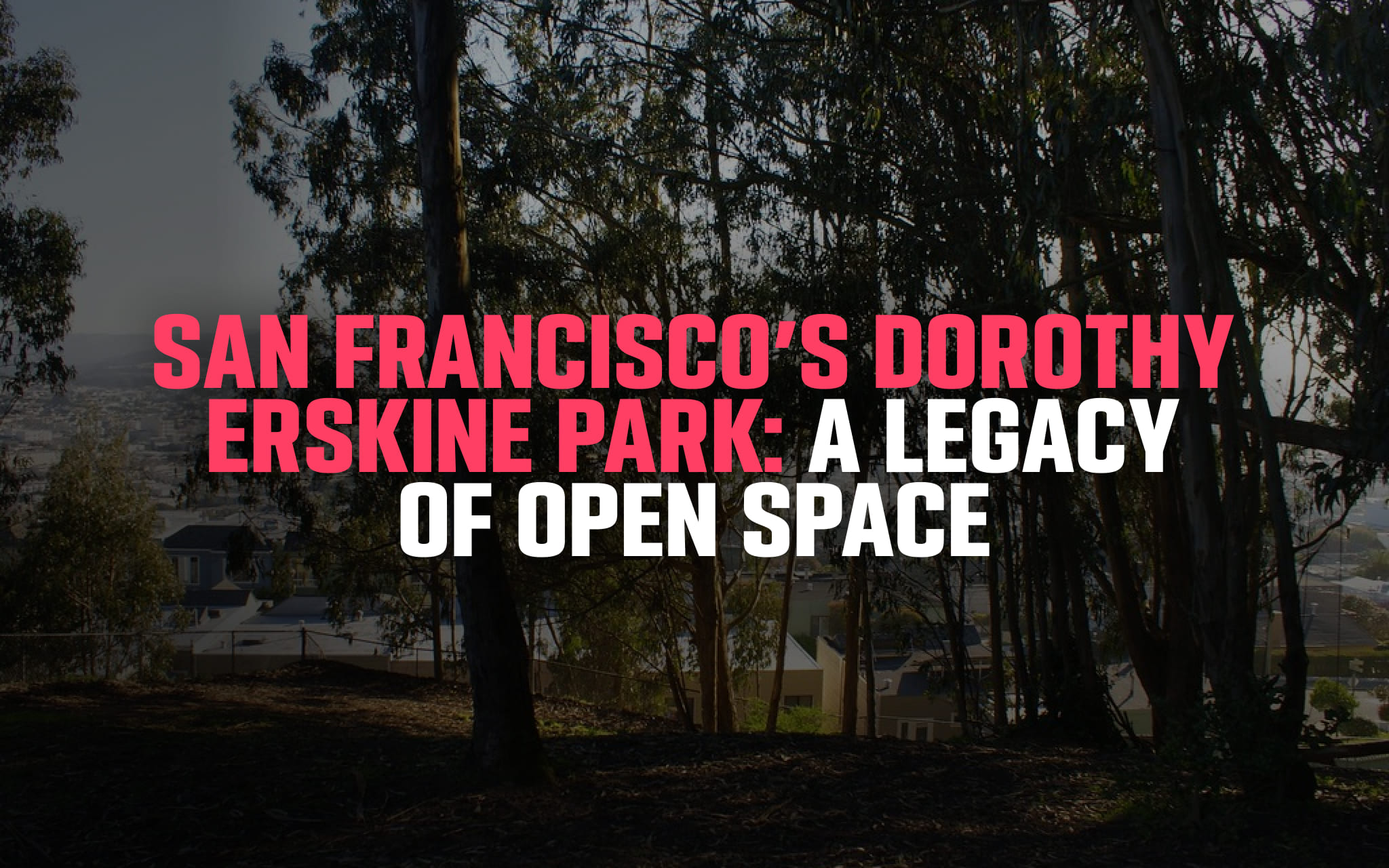
Dorothy Erskine Park honors one of San Francisco’s most passionate voices for preserving open space. Dorothy Erskine championed urban planning that respected both people and the natural landscape, advocating for green corridors long before they became a civic priority. Her work with the Greenbelt Alliance and SPUR established her as a visionary who helped protect the city’s hillsides and waterfronts from unchecked development.
The land that would become Dorothy Erskine Park was once a rugged and overlooked hillside, gradually reclaimed through the efforts of neighborhood advocates inspired by Erskine’s ideals. In 1979, the city dedicated the area as a public park in her name, recognizing her tireless commitment to environmental stewardship. That gesture cemented her legacy in a tangible, living landscape—a space that embodies her belief that every community deserves access to nature.
Today, visitors who step into Dorothy Erskine Park experience the result of decades of dedication to conservation and civic pride. It’s more than a neighborhood greenbelt; it’s a symbol of how thoughtful activism can shape a city’s future. Every path and vista reflects Erskine’s enduring influence and the gratitude of a community that continues to honor her work.
Location, Access, Terrain & Natural Features
Dorothy Erskine Park lies where the Sunnyside and Glen Park neighborhoods meet, stretching across a steep hillside between Martha Avenue and Baden Street. The terrain is rugged and untamed, giving the park its distinct character and offering panoramic views that reward anyone willing to make the climb. The combination of rock outcrops and rolling grasses creates a natural contrast to the dense city grid below.
The landscape of Dorothy Erskine Park showcases California’s resilient ecology. Native plants such as buckwheat, sticky monkey flower, and sage thrive here, attracting pollinators and lending bursts of color through the seasons. Birdwatchers often spot red-tailed hawks circling overhead or songbirds flitting through low shrubs, making the park a rewarding stop for anyone with binoculars and patience.
Though compact, the park feels surprisingly expansive thanks to its elevation and sense of isolation. Narrow trails weave between boulders and patches of wildflowers, leading to quiet perches that open onto wide, cinematic views. This connection between the small-scale urban landscape and the grand sweep of the city below perfectly captures what Dorothy Erskine envisioned—a natural refuge set against the rhythm of metropolitan life.
Visitor Experience & What Makes It Special
There’s a serenity in Dorothy Erskine Park that feels rare in a modern city. Locals often describe it as a secret escape, where the hum of traffic fades into birdsong and the only sounds are the wind and rustling leaves. The park’s elevation offers glimpses toward the southeastern neighborhoods and even the bay on clear days, creating a peaceful setting for reflection or photography.
This quiet sanctuary also reflects the dedication of local volunteers who continue to restore and care for the park’s habitat. Community groups organize cleanups, remove invasive plants, and reintroduce native species that once flourished on these hillsides. Their work keeps the area true to Erskine’s original vision of a living, self-sustaining landscape that benefits both wildlife and people.
Every visit to Dorothy Erskine Park feels personal—an unhurried connection to San Francisco’s wilder side. Without playgrounds, kiosks, or large crowds, the park invites visitors to slow down and rediscover the pleasure of simple beauty. It remains one of those places that reward those who look for meaning in quiet details and open skies.
Practical Tips for Visitors
Visitors will find Dorothy Erskine Park accessible from residential streets but should be prepared for uneven trails and steep inclines. The terrain is natural rather than manicured, making sturdy shoes a smart choice for those exploring the hillside paths. Early mornings and late afternoons often provide the best light for photography and the calmest conditions for a relaxing walk.
Public transit routes stop within a short distance, and the park can easily be added to a day of exploring Glen Park or Sunnyside. Because there are no restrooms or drinking fountains, bringing water and essentials is important. The minimal infrastructure keeps the experience authentic—exactly as Dorothy Erskine intended, blending city living with open-space simplicity.
Whether you’re walking a dog, photographing native blooms, or seeking a quiet corner for contemplation, this park delivers a rare experience: wilderness within reach. From the topmost ridges, visitors can trace the city skyline and understand how Erskine’s vision shaped these shared natural spaces for generations to come.
Perspectives in Art and Space: The Museum of 3D Illusions
Just as Dorothy Erskine Park transforms perspective through its sweeping views, the Museum of 3D Illusions in San Francisco reimagines how we see space and depth. Its immersive galleries allow visitors to step into painted worlds that challenge the senses. One display lets guests leap across rivers of molten lava cascading through Lombard Street, while another transforms them into a butterfly fairy. There’s even a scene where they can soar across the Golden Gate Bridge on a magic carpet, seeing the city in a completely new dimension.
The museum’s creative energy contrasts beautifully with the natural calm of Dorothy Erskine Park. Both encourage exploration—one through the landscape’s contours, the other through the imagination’s boundless reach. At “Smash It!”, visitors can release tension by shattering decorated plates, transforming emotional energy into an artistic act of renewal, much like restoring the spirit after a day outdoors.
Together, these experiences celebrate different sides of San Francisco’s character: grounded in nature yet endlessly inventive. Pairing a visit to Dorothy Erskine Park with the Museum of 3D Illusions creates a day that moves from tranquil earth to vivid fantasy, reminding visitors how perception can turn even familiar surroundings into something extraordinary.
Why Dorothy Erskine Park Matters & Encouragement to Visit
Dorothy Erskine Park stands as a tribute to a woman who saw the potential of green space long before it was fashionable to defend it. Her foresight gave future generations a way to reconnect with the land without leaving the city behind. Every path reflects her belief that urban progress and environmental preservation can coexist when guided by care and community spirit.
The park’s continued survival in a city known for rapid change demonstrates the enduring relevance of Erskine’s ideals. It’s a living classroom where visitors can witness firsthand how native plants reclaim hillsides and how simple public spaces become sanctuaries through stewardship. In every sense, it embodies the legacy of advocacy turned into action.
For travelers and locals alike, Dorothy Erskine Park offers a reminder of what makes San Francisco special: its ability to balance beauty, history, and purpose in a single view. Taking the time to walk its trails is not just an outing—it’s a small tribute to Dorothy Erskine herself and to the power of preserving natural places amid the pulse of a great city.
FAQ
Where is Dorothy Erskine Park located and how can visitors explore it?
Dorothy Erskine Park sits between the Sunnyside and Glen Park neighborhoods in San Francisco. Visitors can enjoy walking paths, panoramic viewpoints, and quiet natural areas ideal for photography or birdwatching while experiencing the vision of Dorothy Erskine brought to life.
How does Dorothy Erskine Park connect to San Francisco’s artistic attractions?
Dorothy Erskine Park pairs beautifully with creative destinations like the Museum of 3D Illusions, where perspective and imagination come alive. Both highlight the city’s talent for blending nature, art, and innovation into immersive experiences that celebrate discovery and inspiration.


